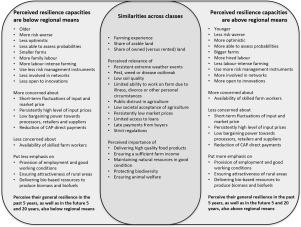Agricultural Systems ( IF 6.1 ) Pub Date : 2021-07-23 , DOI: 10.1016/j.agsy.2021.103224 Alisa Spiegel 1 , Thomas Slijper 1, 2 , Yann de Mey 1 , Miranda P.M. Meuwissen 1 , P. Marijn Poortvliet 2 , Jens Rommel 3 , Helena Hansson 3 , Mauro Vigani 4 , Bárbara Soriano 5 , Erwin Wauters 6 , Franziska Appel 7 , Federico Antonioli 8 , Camelia Gavrilescu 9 , Piotr Gradziuk 10 , Robert Finger 11 , Peter H. Feindt 12

|
CONTEXT
The ability of a farm to cope with challenges is often conceptualised as resilience. Although improving resilience of farms is a major policy goal in the European Union, the current state of resilience is often unknown. Previous resilience assessments have been based either on pre-defined indicators or on perceptions. In particular, empirical research of perceived resilience is still limited and usually restricted to one specific resilience capacity, one challenge, or one function.
OBJECTIVE
We investigate how European farmers perceive resilience capacities of their farms. Extending beyond previous research, we cover all three resilience capacities (robustness, adaptability, and transformability), consider a broad range of short-term shocks and long-term stresses, and include multiple functions. Furthermore, we analyse farms from diverse farming systems across Europe and investigate whether farms and farmers with similar perceived resilience capacities share characteristics.
METHODS
We address the complex nature of resilience capacities by accounting for multiple scales formulated as analytical steps of a resilience assessment framework. More specifically, these are ‘resilience of what’ (farms and farming systems), ‘resilience to what’ (challenges), ‘resilience for what purpose’ (functions), and ‘what enhances resilience’ (resilience attributes). These steps guided the development of a survey with farmers across eleven European farming systems. Based on three indices for each farmer indicating perceived robustness, adaptability, and transformability of their farms, we identified two classes of farmers with particularly strong and weak resilience profiles respectively. Using nonparametric Mann-Whitney U tests, we furthermore compared other parameters collected via the survey across the identified classes.
RESULTS AND CONCLUSIONS
Our data sample outputs two classes of similar size characterised by all three perceived resilience capacities being above (below) regional average. This finding suggests that the perceptions of robustness, adaptability, and transformability are mutually dependent. Furthermore, we found that farmers who perceive their resilience above the regional averages are characterised by lower risk aversion, greater focus on providing public goods, a higher number of implemented risk management strategies, more active involvement in networks, and greater openness to innovation.
SIGNIFICANCE
The revealed links between particular characteristics of farms and farmers and different levels of perceived resilience capacities can support policy-makers in developing more targeted resilience-enhancing strategies, as well as in understanding farmers' responses to challenges. Finally, our results can serve as a basis for further research, e.g., for formulating and testing hypotheses on causal effects between perceived resilience and its components, and on links between perception- and indicator-based resilience assessments.
中文翻译:

欧洲农民认为的抗灾能力
语境
农场应对挑战的能力通常被概念化为复原力。尽管提高农场的复原力是欧盟的一项主要政策目标,但复原力的当前状态通常是未知的。以前的复原力评估要么基于预先定义的指标,要么基于感知。特别是,感知弹性的实证研究仍然有限,通常仅限于一种特定的弹性能力、一项挑战或一种功能。
客观的
我们调查了欧洲农民如何看待他们农场的恢复能力。超越先前的研究,我们涵盖了所有三种恢复能力(稳健性、适应性和可转换性),考虑了广泛的短期冲击和长期压力,并包括多种功能。此外,我们分析了来自欧洲不同农业系统的农场,并调查了具有相似感知能力的农场和农民是否具有共同特征。
方法
我们通过考虑作为弹性评估框架的分析步骤制定的多个尺度来解决弹性能力的复杂性。更具体地说,这些是“对什么的弹性”(农场和农业系统)、“对什么的弹性”(挑战)、“出于什么目的的弹性”(功能)和“什么增强弹性”(弹性属性)。这些步骤指导了对十一个欧洲农业系统的农民进行的调查。基于每个农民的三个指标,表明他们的农场感知到的稳健性、适应性和可转变性,我们确定了两类农民,分别具有特别强和特别弱的弹性特征。使用非参数 Mann-Whitney U 测试,我们进一步比较了通过调查收集到的其他参数。
结果和结论
我们的数据样本输出两个大小相似的类别,其特征是所有三个感知的弹性能力都高于(低于)区域平均水平。这一发现表明,对稳健性、适应性和可转换性的看法是相互依赖的。此外,我们发现,认为自己的弹性高于区域平均水平的农民的特点是风险规避程度较低,更加注重提供公共产品,实施的风险管理策略数量较多,更积极地参与网络,对创新更加开放。
意义
所揭示的农场和农民的特定特征与感知的不同复原能力水平之间的联系可以支持决策者制定更有针对性的复原力增强战略,以及了解农民应对挑战的反应。最后,我们的结果可以作为进一步研究的基础,例如,制定和测试关于感知弹性及其组成部分之间因果关系的假设,以及基于感知和指标的弹性评估之间的联系。











































 京公网安备 11010802027423号
京公网安备 11010802027423号